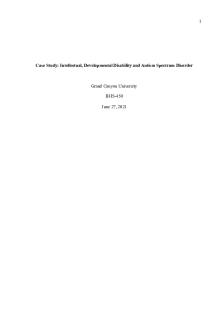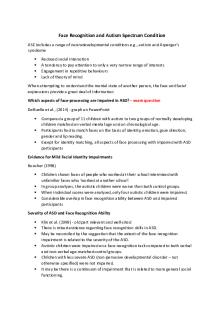Autism PDF

| Title | Autism |
|---|---|
| Course | Pathophysiology for Occupational Therapy |
| Institution | Australian Catholic University |
| Pages | 4 |
| File Size | 268.6 KB |
| File Type | |
| Total Downloads | 7 |
| Total Views | 162 |
Summary
Condition profile for Autism...
Description
OTHY103 Pathophysiology for Occupational Therapists
Condition Profile for ___Autism____
Definition of condition Autism is a neurological condition which can range from mild to severe impacts on an individual. It effects social skills, communication abilities, thought processes/decision making and overall behaviour. Autism is considered to be on a spectrum, thus meaning is can show different effects on individuals, for example some may show impaired social skills whereas others have impaired reasoning skills. All individuals that are diagnosed with autism will have impairments in three key areas, these are social interaction, communication and reasoning. Asperger Syndrome is part of the spectrum of autism. It describes an individual with autism that have autism surrounding language skills and comprehension. Social cues, body language, eye contact and different speech expressions (sarcasm, seriousness etc) are aspects of social relationships that people with Asperger’s syndrome struggle with.
Outline primary body/organ system/s involved The Central Nervous System (CNS) is comprised of the brain and the spinal cord. It is mainly responsible for unconscious and conscious process and body functions. The CNS is made primarily of neurons (nerve cell) which are responsible for transmitting messages from the body to the brain and back. The Brain is responsible for the receiving and procession of sensory information, coordinating and initiating movement and processes thoughts and cognition. Being the powerhouse of the body, the brain is also responsible for information storage and retention, emotion regulation and expression and behavioural characteristics. The Cerebellum is considered to be part of autism spectrum disorder. The cerebellum is one of the main powerhouses for coordinating movement, however, studies show that it has a direct effect with autism spectrum disorder.
Incidence and Prevalence and population affected
OTHY103 Pathophysiology for OT
Revised: Daniel Clohesy ACU 2017
Autism is estimated to be found in 1 for every 160 children. This number, however, is subject to change as recording data in low and middle income countries is often difficult to measure. Autism spectrum disorder is becoming more popular globally which could be due to factors such as more education about the condition, improved diagnostic tools and reporting manners have become better. (WHO, 2018) The risk of having autism spectrum disorder between males and females is very different. Males have a 3-4 higher risk of having ASD when compared to females (GALE, 2010). The Centers for Disease Control and Prevention claim that ASD is shown to be present in all racial, ethnic and socioeconomic groups, thus showing that environment/location/SES/etc does not influence the likelihood of an individual having autism. Australian statistics show that autism spectrum disorder: - effected 164,000 Australians in 2015 (of all ages) (an increase of 100,000 cases from 2009) - 1 in 150 (0.7%) people in Australia will have ASD - ASD is most prevalent in people aged under 25 (83% of autism cases) - Males are four times as likely to have autism when compared to females Presentation Autism is an entirely mental condition, so there are no physical signs or symptoms of having autism spectrum disorder. Being on a spectrum, every individual will have a different level of abilities and deficits. Some of the more common symptoms of autism include: - language development delays - Word or phrase repetition - Deep understanding of phrases or words - Difficulty in language initiation and holding Deficits in social interactions and social behaviours include: - absent attachment to parents/families/friends - No desire for friendship development or group play - A lack of interest for pretend game play with others (lack of imagination) Behavioural symptoms of autism are in a vast range, including: - Hyperactivity - Inappropriate touching/laughing - Serious screaming/crying/yelling fits - Muscle tone (rigid or flaccid) when held/interacted with physically Causes / Aetiology/Risk factors Although there is not a particular cause of autism spectrum disorder, many studies have claimed that children with older parents are at a higher risk of having autism. A study by Reichenberg et al. concluded that older males (40 years and over) are at a 5.75 times higher chance of having a child with autism. There is no indefinite gene that can determine whether or not an individual will have autism spectrum disorder, however, 2-15 genes are thought to be involved with autism. Other causes include: - Genetics - Environmental factors - Infections However, these causes are not found to be completely evident of causing autism as there is no known cause. Progression and prognosis
OTHY103 Pathophysiology for OT
Revised: Daniel Clohesy ACU 2017
Autism is typically diagnosed during early childhood and even infancy. The progression of how autism influences someones life can either get worse or better, but due to the idiosyncratic nature of autism, each invidious will experience symptoms differently. Language abilities and social interactions with others will typically remain constant throughout the individuals life. With children, moving into late childhood and adolescents will show different abilities either becoming worse or better due to the lifestyle change. Progression of other symptoms such as episodes of hyperactivity, improper muscle tone during activities and moving/fiddling may be present during the entirety of an individuals life. However, depending on how an individual perceives therapy or other interventions that assist in the maintenance of symptoms, symptoms and side effects may improve or become worse as time progresses on.
Treatment/Intervention: Common medical interventions and management approaches including surgical, pharmacological, lifestyle and psychological Autism, being a disorder that cannot be targeted prenatally, does not have a cure. Autism, to be treated, is merely done through time and treatment/therapy. This is due to behaviours and characteristics changing throughout the individuals life. Therapy interventions, typically, are over a longer period of time and are rather intense and exceptional, which many individuals find uncomfortable, so finding the correct treatment may take time. Throughout an individuals life, many tests and interviews will be conducted to determine their level of social and behavioural development. Parent and caregiver analysis is also required for therapists to determine the severity of the condition, health professionals/therapists will also analyse a particular persons level of development. Lifestyle interventions for children in particular with autism spectrum disorder include a specialised educational system. This includes having a well structured and thorough education system that takes into consideration that individuals particular impairments and strengths. Therapists are highly recommended to help an individual with autism to develop in the most beneficial way possible. Speech pathologists are used in order to help, mostly children, to develop their speech and word pronunciation techniques and ability. Occupational therapists are also administered in order to develop grooming/self-care regimes that are specific to their physical abilities (fine-motor skills). Therapies that may also be considered for individuals with autism include dietary interventions, music therapy, physical therapy and vision therapy. Medications are being administered to individuals with particular types of autism. Children are most often administered these drugs to aid with development. Psychostimulants, clonidine or tricyclic antidepressants (used for hyperactivity and attention issues) are used. Lithium is also used for individuals with anger issues and aggressive behaviours and serotonin reuptake inhibitors are also used for those with anxiety disorder issues.
References:
OTHY103 Pathophysiology for OT
Revised: Daniel Clohesy ACU 2017
Reichenberg, A., Gross, R., Weiser, M., Bresnahan, M., Silverman, J., Harlap, S., ... & Knobler, H. Y. (2006). Advancing paternal age and autism. Archives of general psychiatry, 63(9), 1026-1032. Centers for Disease Control and Prevention. (2019). Autism Spectrum Disorder: Data & Statistics. Retrieved from https://www.cdc.gov/ncbddd/autism/data.html Australian Government. (2015). Autism in Australia. Retrieved from https://www.aihw.gov.au/reports/ disability/autism-in-australia/contents/autism Autism Speaks. What Is Autism?. Retrieved from https://www.autismspeaks.org/what-autism Rogers, T. D., McKimm, E., Dickson, P. E., Goldowitz, D., Blaha, C. D., & Mittleman, G. (2013). Is autism a disease of the cerebellum? An integration of clinical and pre-clinical research. Frontiers in systems neuroscience, 7, 15. Fundukian, L,. & Wilson, J. (2008). Autism. Retrieved from https://go-galecom.ezproxy1.acu.edu.au/ps/retrieve.do? tabID=T003&resultListType=RESULT_LIST&searchResultsType=SingleTab&searchType=BasicSea rchForm¤tPosition=2&docId=GALE%7CCX2699900047&docType=Disease%2FDisorder+ov erview&sort=Relevance&contentSegment=&prodId=GVRL&contentSet=GALE%7CCX2699900047 &searchId=R1&userGroupName=acuni&inPS=true Completed by:
OTHY103 Pathophysiology for OT
Date:
Revised: Daniel Clohesy ACU 2017...
Similar Free PDFs
Popular Institutions
- Tinajero National High School - Annex
- Politeknik Caltex Riau
- Yokohama City University
- SGT University
- University of Al-Qadisiyah
- Divine Word College of Vigan
- Techniek College Rotterdam
- Universidade de Santiago
- Universiti Teknologi MARA Cawangan Johor Kampus Pasir Gudang
- Poltekkes Kemenkes Yogyakarta
- Baguio City National High School
- Colegio san marcos
- preparatoria uno
- Centro de Bachillerato Tecnológico Industrial y de Servicios No. 107
- Dalian Maritime University
- Quang Trung Secondary School
- Colegio Tecnológico en Informática
- Corporación Regional de Educación Superior
- Grupo CEDVA
- Dar Al Uloom University
- Centro de Estudios Preuniversitarios de la Universidad Nacional de Ingeniería
- 上智大学
- Aakash International School, Nuna Majara
- San Felipe Neri Catholic School
- Kang Chiao International School - New Taipei City
- Misamis Occidental National High School
- Institución Educativa Escuela Normal Juan Ladrilleros
- Kolehiyo ng Pantukan
- Batanes State College
- Instituto Continental
- Sekolah Menengah Kejuruan Kesehatan Kaltara (Tarakan)
- Colegio de La Inmaculada Concepcion - Cebu















